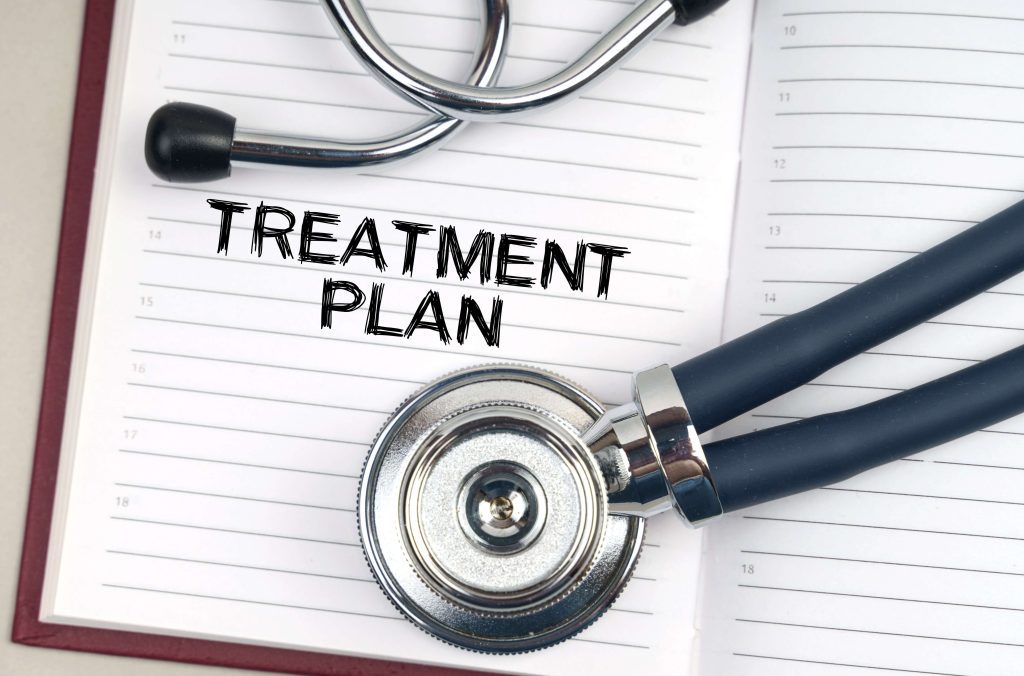Treatment Plan Examples
In the realm of mental health and addiction treatment, the creation of a detailed treatment plan stands as a cornerstone of effective patient care. Utilized by a broad spectrum of health professionals—including psychiatrists, psychologists, counselors, and social workers—these plans serve as a roadmap for treatment, facilitating progress tracking, organization, and personalized care.
At the core of our approach is recognizing each patient’s uniqueness. Our team, composed of seasoned clinicians, collaborates closely with patients to craft treatment plans grounded in evidence-based methodologies. This process directs patients toward recovery and growth and instills a sense of direction and purpose in their journey towards healing.

What Is a Treatment Plan?
A treatment plan is a detailed plan tailored to the individual patient and is a powerful tool for engaging the patient in their treatment. Treatment plans usually follow a simple format and typically include the following information:
- Individualized means that problems that are identified in the assessment process must be “addressed”—whether the treatment planned them refer them (because your treatment center doesn’t provide that service), or deferred them (because it’s not a good time, such as if the patient needs to be stabilized before job hunting)
- Goal and Action-Oriented means the treatment plan must include the Goals to be reached that address each problem.
- Information from the assessment includes the diagnosis and medical/physical exam.
- Patient-Centered. Treatment planning is a team effort between the patient and the health specialist. Both parties work together to create a shared vision and set attainable goals and objectives.
Key Components of a Treatment Plan
A comprehensive treatment plan typically encompasses:
- Patient Information: Critical for personalizing the treatment, including details like name, social security number, insurance information, and contact details.
- Diagnostic Summary: An overview of the patient’s current mental health issues, informed by thorough assessments.
- Treatment Goals and Objectives: Clearly defined, measurable goals and objectives tailored to address the identified issues, complete with achievable timelines.
- Progress Tracking: Dedicated space within the plan for monitoring patient progress and adapting the treatment as necessary.
Crafting a Patient-Centered Treatment Plan
Effective treatment planning is inherently collaborative, requiring active participation from the patient and healthcare provider to set realistic goals and actionable steps. This partnership ensures that the treatment plan addresses immediate issues and lays a foundation for sustained health and well-being.

Treatment Plan Template
A treatment plan is simple but specific. Although treatment plans vary, a treatment plan template or form generally contains the following fields:
- Patient information: At the top of the treatment plan, the counselor will fill in information such as the patient’s name, social security number, insurance details, and the date of the plan.
- Diagnostic summary: Next, the counselor will fill out a summary of the patient’s diagnosis and the duration of the diagnosis.
- Problems and goals: The third section of the treatment plan will include issues, goals, and a few measurable objectives. Each issue area will also include a time frame for reaching goals and completing objectives. Counselors should strive to have at least three goals.
- Signatures: The final section of the treatment plan is where the counselor and the client sign their names. This signifies that the patient participated in developing the treatment plan and agrees with the content.
Treatment Plan Example (PDF To Download)


The structure and intent behind treatment plans are fundamental in navigating the complexities of mental health and addiction treatment. By emphasizing individualized care, goal orientation, and therapeutic partnership, we enhance our capacity to guide patients through their recovery with clarity and empathy.
Published: March 07, 2024
Last Updated: August 24, 2025

Published: December 15, 2025
Behavioral Health During the Holidays: Managing Stress, Anxiety & Emotional Triggers
Why the Holidays Are Harder Than They Look? For many people, the holiday season is portrayed as joyful and restorative. In reality, December is one of the most emotionally challenging months of the year, especially for individuals navigating mental health conditions, substance use recovery, or emotional regulation difficulties. According to the National Alliance on Mental […]
Read more
Published: December 12, 2025
Identity Disorders (DID): When Sense of Self Becomes Unstable
A stable sense of identity helps people understand who they are, how they relate to others, and what gives their life meaning. When identity becomes fragmented, unstable, or unclear, it can significantly affect emotional well-being, relationships, and recovery from mental health or substance use disorders. Identity-related disorders are complex and often misunderstood. At Overland IOP, […]
Read more
Published: November 28, 2025
What Causes Seasonal Affective Disorder?
Seasonal Affective Disorder (SAD) is not simply a reaction to colder weather or shorter days. It is a form of depression influenced by biological, environmental, and psychological factors that interact with seasonal changes. Understanding what causes SAD can help individuals recognize symptoms early and seek effective treatment. According to the National Institute of Mental Health […]
Read more
